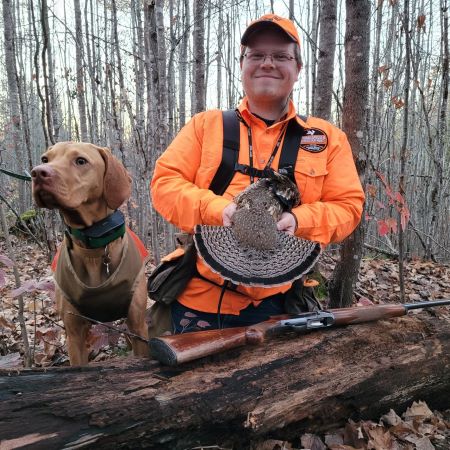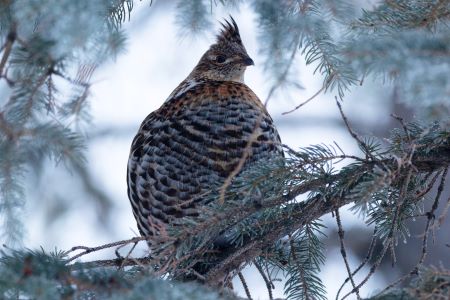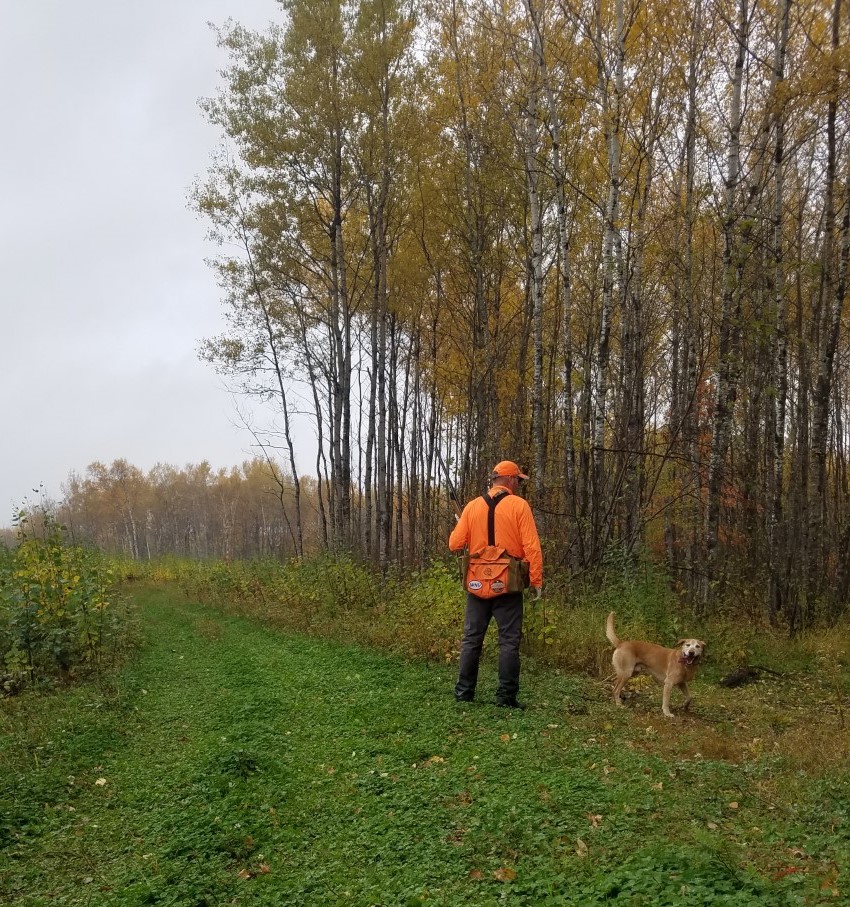Habitat Champion Jon Steigerwaldt is All Ears When it Comes to Nurturing Ruffed Grouse Country
Come early spring in the forests of the Upper Midwest is when you listen for them.
Through the songs of warblers, loons, blue jays and nuthatches, your ears detect the drumming of male ruffed grouse beating their wings to attract females and repel rivals. It’s breeding season in this part of America, and the low-frequency, rapid-thumping broadcast permeates the hardwood, conifer, jack pine, chestnut and aspen trees of the male’s territory. For wingshooters, scientists and naturalists the intensity of the drumming through the woods foretells of the season’s hunt – and habitat work that still needs to be planned for the to birds thrive.
For the rest of us, the telltale drumming signals that it’s time to clean that side by side, waterproof those boots and stock up on shells.

Jon Steigerwaldt
Jon Steigerwaldt is the Forest Conservation Director of the Great Lakes/Upper Midwest region of the Ruffed Grouse Society/American Woodcock Society. He oversees the non-profit’s programs in Ohio, Indiana, and both the Upper and Lower Peninsulas of Michigan. Jon works with teams of foresters, ecologists, biologists and natural resources managers in RGS/AWS and partner organizations.
Jon is here to give you the skinny on what to expect for the 2024-2025 ruffed grouse season in the Great Lakes region of Minnesota, Michigan and Wisconsin – legendary ruffed grouse country – based on the most recent drumming numbers that the conservation group has compiled.
“We’re seeing some positive reports from ruffed grouse drumming counts in states like Wisconsin and Minnesota that directly speak to the importance of sustainable, science-based forest management,” he told us. ‘The drumming counts are up this year, that’s a positive indicator. Part of what we’re seeing this year is partly influenced by variations in climate for grouse survivability. We’ve had some unique variations, anomalies in the past seven years that could be described as a destabilization of the grouse drumming cycle as a result of climate change in our tri-state region. We had poor conditions this spring with a lot of flooding and rain.”

A male ruffed grouse drumming.
Every spring, typically starting in April, it’s a ritual of scientists and staff members of the RGS/AWS Upper Midwest Region to head for the woods where they inspect habitat and log drumming counts.
“We can acoustically detect them,” Jon said of the birds. “It’s an indication of the number of ruffed grouse per location. Its not necessarily an indication of the number of birds, but a broader interpretation of how they’re doing over time. Like what are the longer term population trends? Ruffed grouse are a cyclical species and we look at our drumming index for the long term.”
And, he added, ruffed grouse hunters including himself “want to know where the population is during that cycle.”
It’s the trends that are of particular importance to Jon and the people he works with, because the drumming relates to the management and prioritization of habitat conditions and programs funded and implemented by the RGS/AWS and their partners in designated Grouse Management Areas (GMAs) and elsewhere. For example, Wisconsin has a GMA of roughly 250,000 acres. And although it’s nearly impossible to get a strict bird count based on drumming, Jon clarified that “the drumming counts are a snap shot” of the birds’ population and a barometer of their habitat’s health.

Ruffed grouse will take to evergreen trees.
“Ruffed grouse really require diverse forests,” he explained. “In the fall, ruffed grouse are found in young forests, but they are also found in mid-age and old forests. From spring through fall, they’re most likely in old forests. The more diverse the conditions, the more abundant and ruffed grouse and woodcock will be.”
He went on to talk about that for ruffed grouse, those forest age classes need to be in relatively close proximity. “The ruffed grouse occupies ten-to-forty acres. We want to maximize the forest age classes in that ten-to-forty acres.”
In Minnesota, ruffed grouse hunters often harvest more grouse than any other state, in large part, because of the abundance of aspen trees, which are a key food source, according to RGS/AWS. The organization worked with UPM Blandin to plan the creation of six distinct age classes of aspen among 600 acres in the state. As RGS/AWS describes the project “Diversifying the age structure of trees like this helps create ideal grouse habitat.”
The project, seeded by a $5,000 contribution from the Minnesota State Drummer Fund, opened the Snaptail Hunter Walking Trail Area to non-motorized use – creating a hunter walking-trail area through a ruffed grouse habitat of a managed, mature aspen stand and surrounding the trails.

A hunter using Snaptail Hunter Walking Trail at UPM Blandin.
As climate change makes itself felt across the region that Jon manages, RGS/AWS is championing greater habitat diversity “to protect against unpredictable things like flooding,” he said. One diversification project involves planting conifers in aspen stands to against unforeseen circumstances. “Aspen in conifer in aspen stands helps create an escape or thermal cover for the birds in a season of low snow where they would normally hide under 11 inches of snow maintain body temperature and avoid predation.”
The undertaking is enormous. To get the job done, RGS/AWS cooperates with public agencies including the US Forest Service and the Natural Resources Conservation Service, state-level Departments of Natural Resources, county forest management groups and private land owners.
“It’s an all-partners approach,” he noted.
In May 2022, on the web site of the RGS/AWS web site for the Great Lakes/Upper Midwest Featured Habitat Projects, Jon wrote as an introduction to the roster of projects…
“Land, they haven’t found a way to make that out of plastic yet.” These were the words I was left with after a recent conversation with a Chippewa Valley Wisconsin Chapter member of RGS on the scarcity of land and the need to conserve it. That conversation got me thinking more and more about the support RGS & AWS provides to organizations and agencies for their land acquisition goals and endeavors. Support isn’t always seen by our members, but it’s incredibly important to highlight conservation impacts on the ground. That conversation also got me thinking about the need for RGS & AWS to step into the land acquisition, management and ownership arena as part of our Working Forests Model of conservation.”
Jon has both a professional and personal stake in the work done by RGS/AWS. He grew up on 120-wooded acres in Northern Wisconsin, which was his playground for hunting and fishing. Then life came along. Relocating for work, a family, college (he has four different degrees), moving around and living in rentals didn’t give him an opportunity to even get a good bird dog. When he joined RGS/AWS about six years ago, the new job rekindled his love of upland wingshooting.
So he knows first-hand when he says “Are you really not going to hunt ruffed grouse if it’s a bad year? Don’t try to pin your hunting to drumming counts. Don’t wait to buy your new shotgun or new dog based on the drumming counts. We have a lot of hunters who peg their hunting on the drumming counts. Get out there and find out for yourself.”
Irwin Greenstein is the Publisher of Shotgun Life (www.shotgunlife.com) and Young Awesome Hunter (www.yahunter). Visit their Facebook pages to contact him.
Important resources:

Irwin Greenstein is Publisher of Shotgun Life. Please send your comments to letters@shotgunlife.com.


Comments